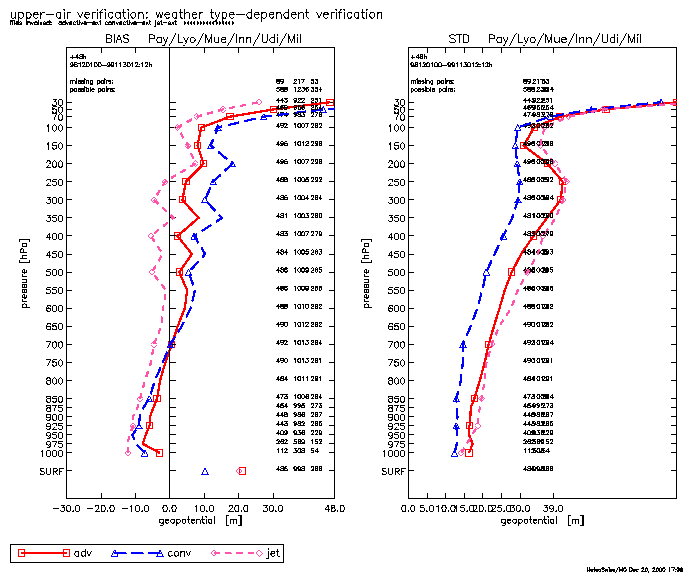
Motivation Alpine weather statistics Scores for selected regimes Summary
The evaluation of the Schüepp classes for the meteorological year 1999 is as follows:40 classes divided into convective, advective, and mixed synoptic situations; over 50 years of weather classification for the Alpine region (~220km radius); partly subjective based on five parameters: surface pressure gradient, surface wind direction, and wind and geopotential height on 500hPa; systematic for 12UTC every day.
|
|
DJF | MAM | JJA | SON | Total |
|---|---|---|---|---|---|
|
advective west
|
6
|
11
|
8
|
1
|
26
|
|
advective north
|
12
|
12
|
2
|
12
|
38
|
|
advective east
|
3
|
4
|
3
|
1
|
11
|
|
advective south
|
5
|
4
|
3
|
11
|
23
|
|
convective high
|
16
|
13
|
14
|
19
|
62
|
|
convective low
|
1
|
7
|
3
|
7
|
18
|
|
convective flat
|
16
|
33
|
51
|
26
|
126
|
|
mixed jet
|
30
|
8
|
8
|
13
|
59
|
|
mixed mix
|
1
|
0
|
0
|
1
|
2
|
As an example, bias and standard deviation of the geopotential height and the temperature profiles are shown in figures 1 and 2 for sounding stations in the Alpine region (Payerne, Lyon, Muenchen, Innsbruck, Udine and Milano). Note that warm/cold biases result in positive/negative biases increasing with height for the geopotential height.
For the meteorological year 1999 we consider the advective, convective and jet classes. As may be expected the standard deviation for the more dynamic synoptic situations (advective/jet) is larger than for the convective situations characterized by generally weaker horizontal gradients.
Concentrating on the convective subclasses high and low, characterized by dry, fair weather and rainy weather, respectively, we note a stronger warm bias from the 900 up to the 350hPa level for the low class at forecast time +48h (fig. 4), which is not present at analysis time (fig. 3). Also, the low class features a drier bias in a substantial portion of the troposphere (c.f. figures 6 and 5, respectively). This is consistent with the hypothesis that the model tends to overestimate moist diabatic processes, that would lead to the warm and dry bias. This in turn would leads to an overestimation of precipitation, which should be apparent as a positive bias in the surface precipitation. Plans are made to extend the weather type-dependent verification to the surface parameters.